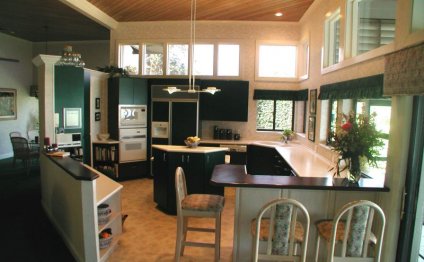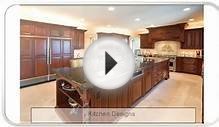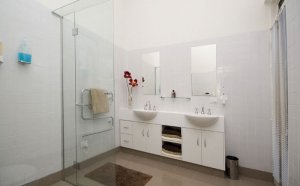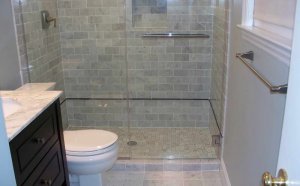
Designs for small Kitchens layout
A lot of home activities — cooking, cleaning, eating, drinking, socializing — take place in the kitchen. That’s why it needs to be both beautiful and functional. Regardless of your kitchen design style, organization and layout are essential. Here are the 10 mistakes to avoid in order to achieve both practical and elegant kitchen design.
1. Obstructing the Kitchen Triangle
Specialists refer to the sink, stove and refrigerator as the kitchen triangle, the area of greatest activity that requires careful planning and unobstructed access. Of the three, the sink typically sees the most action; it should have easy access to the stove and refrigerator, as well as your countertop workstations.
Obviously, your sink needs to be near the plumbing. Sometimes, however, because of the placement of the pipes, kitchens are designed with the sinks in a poor location. If this is the case in your kitchen, consider hiring a plumber to relocate the plumbing to accommodate the best placement for the sink.
Regardless of your kitchen’s size or layout (L-shaped, galley, U-shaped or island), the sum of all the legs in a work triangle should not be less than 10 feet or greater than 25 feet. If the work triangle is too small, people will be tripping over each other; if it’s too large, food preparation could be a tiring task.
2. Wasting Storage Space
Kitchens typically contain lots of stuff. Not only that, but items often concealed behind kitchen cabinets can be oddly shaped and require a lot of space, such as food processors or stand mixers. Finding a home for your appliances while keeping them easily accessible can be tricky.
Because built-ins are expensive and the overall size of the area may be limited, one big design mistake is not including enough storage. Almost every kitchen has wasted space, but this can be minimized with adequate planning and forethought.
If your kitchen is small, consider installing extra-long upper cabinets with molding for extra storage space. Place lighting or greenery along the molding to draw the eyes up. Always install cabinets over the refrigerator; not utilizing this area is a waste of storage space for large or seasonal kitchen items. Finally, install shelves across the backs of the lower kitchen cabinet; this could add up to 4 square feet of storage space.
3. Inadequate Counter Space
One of the biggest complaints about kitchen design is the lack of counter space. Considering all the kitchen activities that require a countertop, as well as appliances that are permanently located there, you want to fit as much open horizontal surface area in a kitchen as possible. This can be achieved by adding an island or breakfast bar to an L-shaped kitchen.
4. Poor Lighting
The kitchen is one room where you can’t afford to have poor lighting. It’s not only a matter of design and atmosphere, but also safety when it comes to handling sharp knives and other kitchen tools. Plus, the more light you have in the room, the better you can show off your design elements.
Rooms generally need three types of lighting: general lighting for overall illumination, task lighting and accent lighting. For your kitchen, evaluate the work areas and focus on providing each spot with the light it needs. Consider adding lighting directly above all the main work areas.
Use pendant lights or a series of mini-pendants to enhance the beauty of the kitchen. Pendants look great above kitchen sinks, while a series of mini-pendants work well over breakfast bars and kitchen islands. Install under-cabinet lighting to ensure that the counters have sufficient lighting for common kitchen tasks.
5. Forgoing a Backsplash
When budgeting or designing a new kitchen or remodel, the backsplash sometimes slips to the end of the list. Occasionally, it’s left out of the plan altogether. This may save you money in the short term, but in the long run it will cost you a lot of time and effort.
Think about all the steam, water and grease in the kitchen, and you’ll understand why installing a backsplash above the cooktop and counters is a smart idea. It is much easier to clean grease off a backsplash made of tile, metal or plastic than paint or wallpaper.
6. Poor Ventilation
The best kitchen design fades in the presence of noxious odors. If you’ve ever walked into someone’s home and smelled last night’s fish lingering in the air, you’ll understand the importance of good ventilation.
Inexpensive range hoods simply circulate dirty, stale air, while a good ventilation system will improve the quality of your indoor air and also help keep your kitchen cleaner. It also helps to extend the life of your appliances.
Although it can be a substantial investment, a good ventilation system will make life easier and more pleasant, especially if your kitchen opens to a living area or family room.
7. Choosing the Wrong Kitchen Island
When it comes to kitchen islands, we generally think of additional storage, preparation and serving space in the kitchen. But the fact of the matter is that kitchen islands can waste a lot of space. Choosing the wrong island or placing it in the wrong spot can be a disaster, especially in a work area that can get overly cluttered.
Islands that obstruct the flow of traffic to and from the sink, refrigerator, stove and primary workstations will create bottlenecks. An island should be at least 4 feet long and 2 feet deep, but it also must have room for people to move and work around it. Specialists say that unless your kitchen is at least 8 feet deep and 12 feet long, you shouldn’t even consider an island.
8. Ignoring Your Recycling
As recycling has become more prevalent, dealing with trash in kitchen design has gone beyond sticking a bin under the sink. Be prepared to manage your trash efficiently — incorporate sorting bins for recylables into your kitchen design.
9. Going Too Trendy
Although it’s not necessarily a mistake, the latest kitchen trends and high-end equipment may not be the best choices. Trendy colors and designs have a short half-life, and you may never see a return on your large investments in the latest kitchenware. Look for kitchen innovations and appliances that are timeless.
10. Not Using Professionals
Taking on a kitchen design project to save money is a common mistake; it can actually waste more money, time and energy. Professional designers have the latest ideas and information, and they can help you identify your needs and translate them into an efficient plan that fits your taste and budget.
RELATED VIDEO



Share this Post
Related posts
Simple bathroom Designs For Small Spaces
Using multiple shades of the same base color can visually expand a teensy bathroom,Barnard says. This bath appears much…
Read MoreBest bathroom Designs for Small bathrooms
Taking a bath should be one of the easiest ways to relax after a long day. You can either unwind in your hot tub or let a…
Read More











